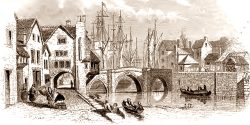Voluntary hospitals were created from the eighteenth century and were initially financed by public public collections, Hospital Saturday Funds and flag days to support the hospitals continued until the 1930s. A voluntary hospital may also be a charitable hospital. By the middle of the 18th century there were five in London. They provided free medical care to those who could not afford it. and were the earliest teaching hospitals. The 1851 census recorded 7,619 patients in hospital in England and Wales. After the First World War the hospitals began to admit private paying patients and by 1921, 171 of the provincial hospitals had pay beds. (Condensed from Wikipedia)
According to Jarman, (1890), the Infirmary’s express aim was to be a Medical Institution for the relief of the labouring poor* requiring medical and surgical assistance in the town and the neighbouring parishes, under the direction of a Committee of Management, which comprised twenty-two clergymen and other gentlemen of the town and neighbourhood of Bridgwater. The President or any two Members of the Committee were to have power to call special meetings of the Committee and three were to form a quorum. Each subscriber of £1 1s 0d to be entitled to recommend in any one year four Out-patients ; a subscriber of £2 2s 0d one In-patient and two Out-patients, or six Out-patients, and so in proportion for every additional guinea subscribed. Each In-patient was to pay to the nurse 5s 6d per week for his board, unless he choose to board himself.
Bridgwater Infirmary was supported by a range of funding enterprises. At the beginning the Bridgwater Glee Club held regular concerts. There were a number of individual subscribers and regular street and village collections were held. Several employers took small sums from employees’ wages –these were very local insurance schemes. There were annual Hospital Sunday services at St Mary’s, where the preachers were drawn from the group of local clergy who formed the Committee. Many of the medical staff gave their services free.
Voluntary fund raising in this way continued until the formation of the NHS in 1948.
*The practice at the time was for more affluent people to pay the doctor to make house calls, and this practice continued all the way to 1948: richer people would only go to these sorts of hospitals for surgery.
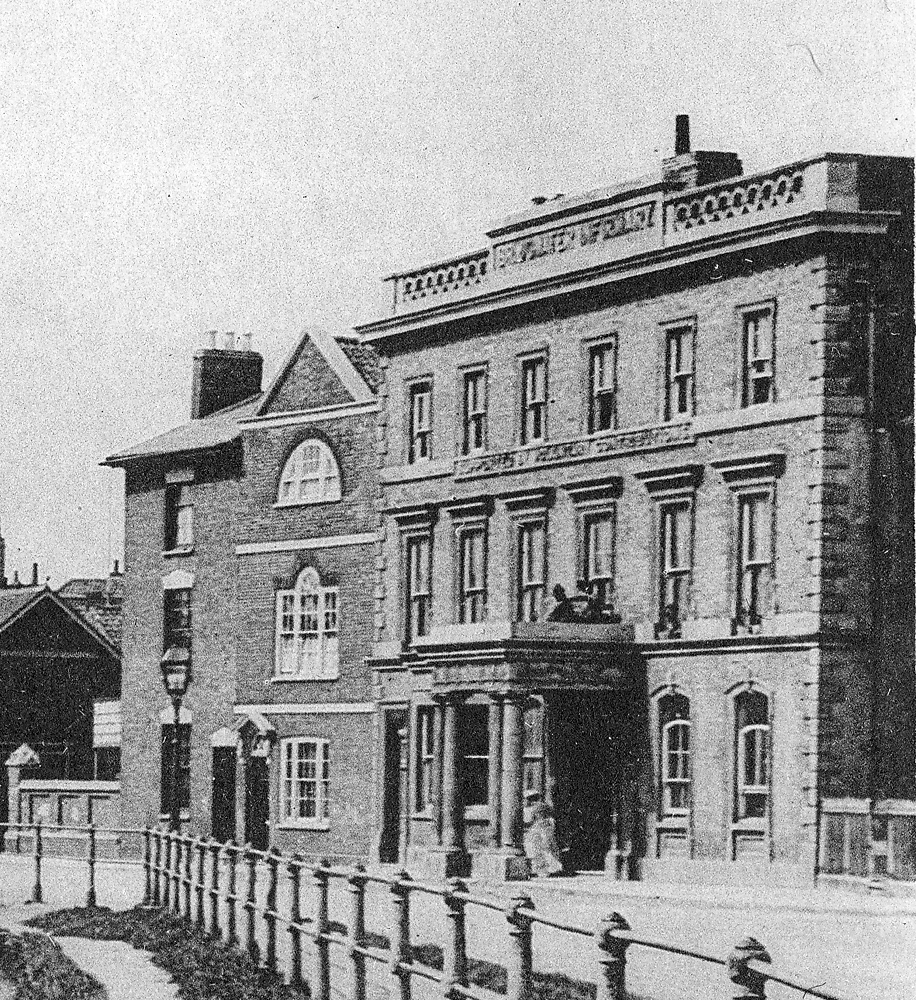
Brief Timeline of Hospital Provision in Bridgwater since 1800
Items in bold relate to the Salmon Parade Infirmary.
1813 June 26. Public meeting to set up the Bridgwater Institution. John Chubb, Treasurer, Morley Chubb Hon Secretary.
Jarman, (1890), noted that a general public meeting was held at the Grand Jury Room on the 26th of July, 1813, and the following were elected as officers:
- President: Sir Philip Hales He lived at Brymore house, near Cannington. (Chubb pix BWRAB: 1977/53/53 and 2004/1/2510)
- Treasurer: John Chubb (Chubb pix BWRAB: 1977/53/8 and 2004/1/22 This has him with grey hair, so appropriate to the ages when he was involved with the Infirmary)
- Honorary Secretary: Morley Chubb
- Physicians: Dr. Dunning and Dr. Haviland. There is a marble monument to Dr John Dunning in the chancel of St Mary’s, Bridgwater. He was a Justice of the Peace., and deputy Lieutenant for the county. He died 11 December 1821, aged 79 [so born in 1742]. The memorial also commemorates his wife, Susanna, daughter of Philip Baker of Bridgwater. She died 17 May, 1824, aged 87. Dr. Haviland (Chubb pix BWRAB: 1977/53/10) Trying to work out the Haviland family is difficult. The family originated in Guernsey, then moved to Bridgwater. ODNB has John Haviland, (1785-1851) son of a Bridgwater surgeon, also named John Haviland. He was based at Cambridge University for all his working life. Presumably, he was a son of John, above, and brother of James below.
- Consulting surgeons: John Symes, John Haviland and William Anstice William Anstice was an apothecary and born at Wellington, and moved to Bridgwater in 1785. He was in partnership with Mr Hill Dawe, and Jonathan Toogood was apprenticed to them 13 October 1798, (Sutcliffe, 2017, p.7)
- Surgeons of the Institution: Jonathan Toogood, Henry Axford, ―Haviland, ―Stradling. The 1818 Bridgwater voters list has James Haviland, surgeon and Edward Stradling, presumably from the Chilton Polden family.
- Honorary Apothecary or Dispenser: Mr. Henry Axford
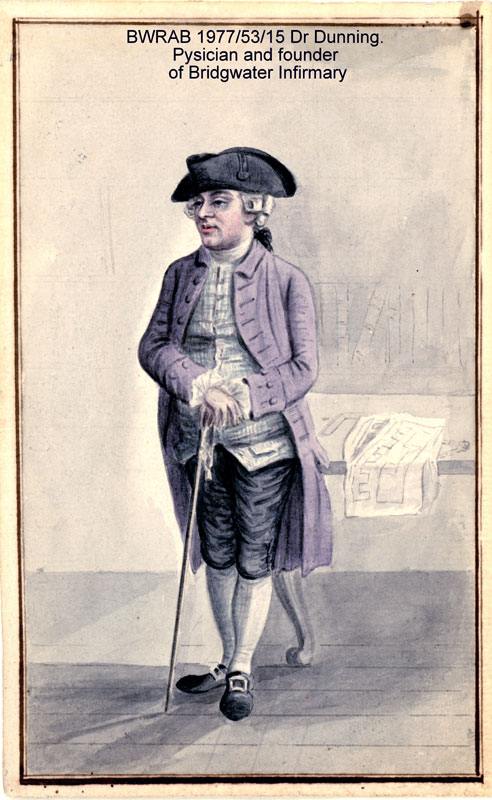
A number were drawn by John Chubb, and it is probable that more portraits are in the unidentified part of the Chubb collection. Biographical material for most is sparse. Dates of birth and date are often not known. At that time medical training was often by apprenticeship, rather than a medical school course and membership of a professional medical institution. Therefore they are not mentioned in medical reference books. More research will be needed on this.
August. House rented in Back Street. Mrs Nancy Burrows was the Matron. Apothocary’s shop set up, 12 beds. October 6. First patients admitted
1818, January 15. John Chubb had died and Morley Chubb took on the roles of Secretary and Treasurer. The 1818 Voters list records Jonathan Toogood, James Haviland and Edward Stradling as surgeons. Stradling is presumably from the Chilton Polden family. Mr. Henry Axford is recorded as Honorary Apothecary or Dispenser.
1820 Morley Chubb resigned, being succeeded by Mr Charles Trevor
July 17. Committee purchased from Mr Holloway the present building on Salmon Parade, comprising a house and garden. To be renamed the Bridgwater Infirmary

1829 A new ward erected at a cost of £335 with £100 spent on further improvements
1837 Two new wards are added to hospital
1840 An Eye Infirmary on ‘Victoria Street’ is opened (although where this is is to be confirmed)
1845 A portrait of Dr Jonathan Toogood is presented to the infirmary (now lost), having been commission in 1843. “Presented to the Bridgwater Infirmary by Subscribers to this Institution, whose names are recorded in the minutes of December 29th, 1845, as a testimony of their grateful sense of the gratuitous and highly valuable services of Jonathan Toogood, Esq, M.D., to this Institution for a period of more than 30 years.”
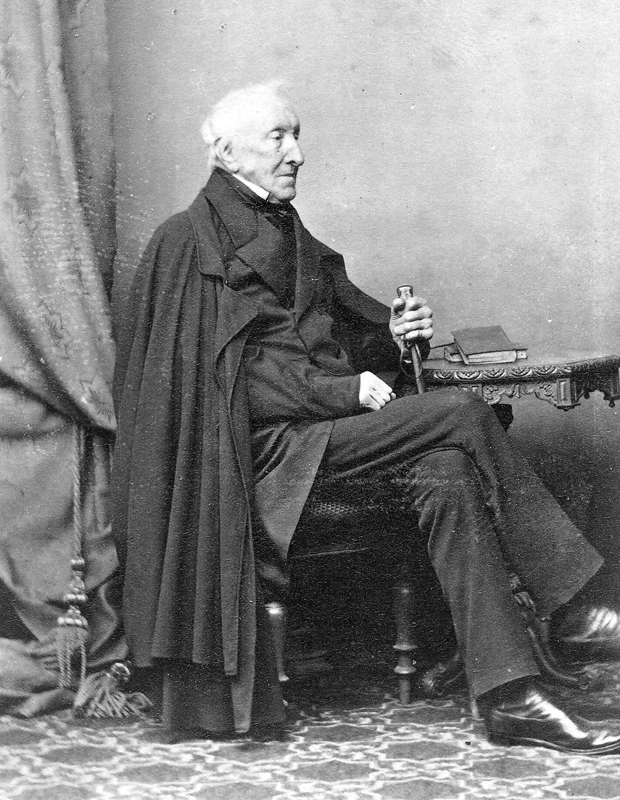
1847 Improvements recommended – bathroom, new operating room, new female ward, matron’s room, laundry etc. Cost £428 14 5.
1849 Cholera epidemic (also 1853) – over 1,000 persons are treated as emergencies without recommendation
1859 Workmen from local manufacturers subscribed to the hospital so they could have treatment.
1861 Mrs Higgins resigned as matron. Appointed 14 years previously. Miss Weaver, late matron of the Bristol Royal Infirmary appointed in her stead.
1862 Miss Weaver died at the Infirmary, and Miss Tresider appointed in her stead.
1863 House and garden next door to the Infirmary purchased for £205
1864 Jubilee fund set up to cover the cost of the new property. £339 1 10 raised.
1865 Miss Tresider resigned. Miss Mary Jones appointed in her stead.

1868 Mortuary erected at the back of the infirmary
1871 Detailed report about utilising the building bought in 1863, and altering the old building. Estimated cost £1000 of which about half was already in hand.
Proposal by the Town Council this year to build a new hospital at North Gate – declined
1872 Infectious diseases hospital opened at the back of the Union Workhouse in North Street. This later becomes the Blake Hospital and survives to 2016.
1873 Improvement works including hot and cold water for upper floors, kitchen upgrade and patient lift total cost £1,430; Hospital Saturday fundraising days established.
1874 June 19. Miss Anderson appointed Matron
1875 Miss Anderson resigned. Miss Atkinson appointed in her stead. Fund-raising concerts instituted. Woman’s day ward added to hospital
1876 Agreed that the front of the hospital would be improved by the addition of a portico. New frontagededicated in memory of GS Poole, Chairman, cost £594.

1877 Description of the accommodation – enough for 40 patients
1882 James Broadmead of Langport leaves an endowment to the Infirmary of £7375, which includes land at Wembdon
1883 August 24 Mrs Atkin resigned as Matron, Miss Corven appointed in her stead
1884 Dietary tables for the patients published.
1887 Mr A Max Sully appointed as House Surgeon
1888 Francis Thompson presents the hospital with freehold dwelling house next to hospital

1889 Freehold dwelling house, garden etc, next door to the hospital given to the hospital
1890 Sidney Gardnor Jarman publishes a history of the Bridgwater Infirmary, which can be read here.
1893 Accountant and collector for hospital appointed; adjoining house used for nursing staff quarters

1900 Vacant beds made available for soldiers of the Yeomanry and Volunteers during the Boer War; house surgeon Rutherford volunteers for active service in South Africa
1902 Operating theatre added to hospital; first x-ray equipment set up.
Nurses training facility opened in Kings Square (moves to Castle Street in 1920)


1903 The in-house laundry closes and sheets are sent to the town’s laundry company
1904 The hospital gets telephone
1910 Installation of electric light system to replace gas lamps

1914 A new wing is built, including staff quarters and mortuary; Hospital used for war casualties; first lady house surgeon appointed

1916 First hospital ‘Pound Day’
1918 Matron Miss Kitching received recognition for nursing from War Office
1920 Mary Stanley Nursing Home opens as Maternity Home in Castle Street
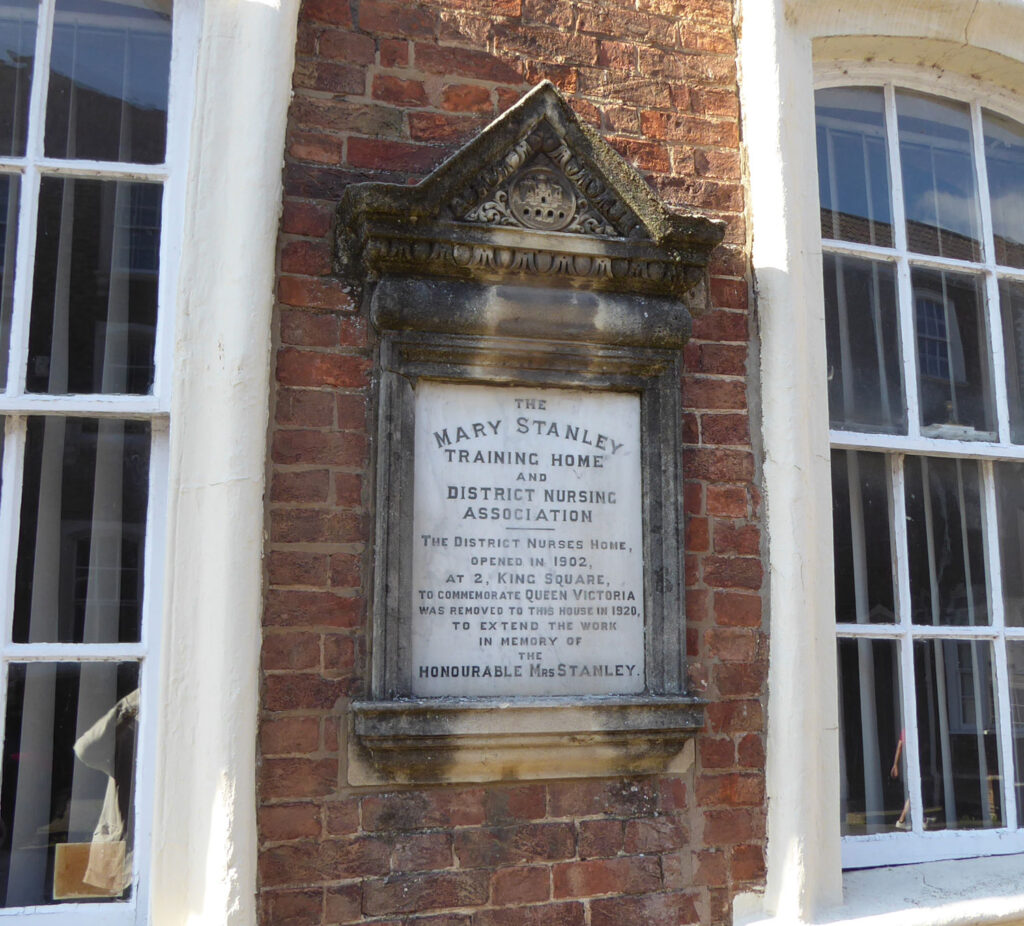

1921 Government announces grants of half a million pounds to hospitals which had done war work including Bridgwater
1922 Lift installed to second and third floors
1928 Fire in hospital due to faulty gas pipe
1929 16 Salmon Parade purchased for £600; complete heating system installed
1930 Miss Tamlin of Bridgwater leaves farm to hospital, revenue to be used for benefit of poor women

1933 Dining room, kitchen, 6 private rooms, new x-ray and casualty, lecture and massage rooms paid for by Carnival Week fundraising
1934 Marquis of Bath opens extension
1936 Pension scheme for nurses and other staff; wireless system installed
1940 Iron Lung apparatus received; second house surgeon engaged due to increase in work
1941 GENERAL HOSPITAL SURGICAL CASES, 1941 from an Anaesthetic Record book
- Hemiglossectomy 64 year old male
- Appendicectomy 20 year old male
- Dissection of tonsils and curetting of adenoids 8 year old female
- Radical amputation breast 60 year old female
- Caeserian section, twin boys to 24 year old female
- Amputation left leg 18 year old female
- Suprapubic cystotomy 75 year old male
- Redressing of burn 27 year old male POW
- Removal of supernumery digit 2 year old male
- Replaster compound fracture of leg 22 year old male
- Sigmoidoscopy 76 year old male
- Nephrectomy 28 year old female
- Plaster jacket for spinal fracture 61 year old male
1945 Purchase of adjoining Coal Yard to extend site for pharmacy, medical records and car park for £2,500
1946 The old Northgate Workhouse is transferred to the NHS and becomes the Blake Hospital
1947 Hospital no longer a complete school of training of SRNs
1948 NHS founded to provide a comprehensive service irrespective of means, age, sex or occupation. The Matron was Miss M Prowse
1961 Princess Alexandra visits Hospital
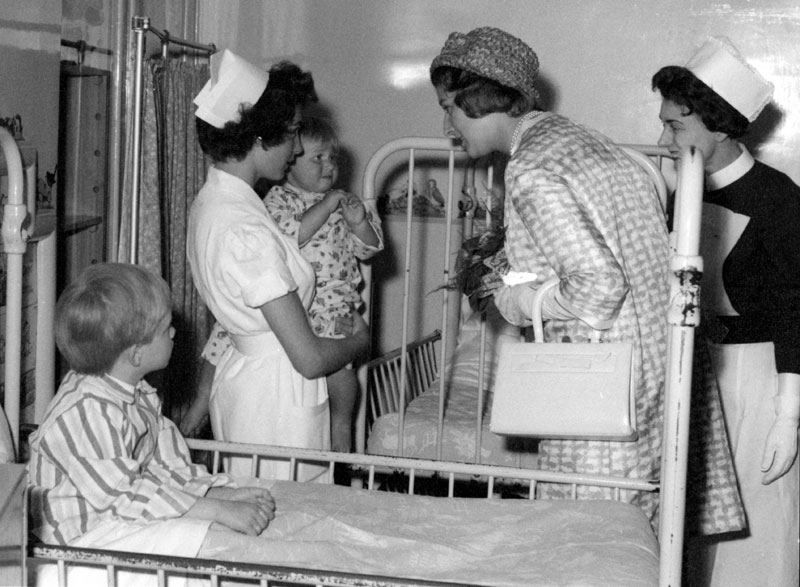

2014 New hospital opens in Bower Lane, the old Infirmary closes.


Matrons and Apothecaries at Bridgwater Hospital (Taken from Jarman)
1813 Mrs Nancy Burrows salary £12 12s 0d
1822 Richard Martin medicine provision and dispensing
1825 Mr Heard medicine provision to value of £90
1830 Mr Baruch Toogood – free dispensing for one year, Mr Varder as dispenser
1833 Mr WC Price
1843 Mr Gunthorpe appointed
1851 Mr Lear house apothecary salary £45 per year, replace by Mr Mowatt
1855 Miss Weaver, Matron, died at Infirmary and replaced by Miss Tresider salary of £25 Mr Hurst apothecary replaced by Mr Steward
1864 Mr H Jacob, dentist replaced by Mr Prideaux
Miss Tresider gave notice and replaced by Miss Mary Jones £25 per annum, 6 weeks notice Mr Thomas Chant, apothecary
1866 Mr Chant apothecary salary increase from £40 to £50
Rev Jc Collins Chapain to Infirmary request that son William would take on the role
1874 Miss Anderson appointed Matron to replace Miss Jones, £40 per annum Miss Anderson resigned and replaced by Miss Atkinson £35 per annum Mr Gilbert resigned as apoth, replaced by Mr WA Smith
1875 Mr Lewis apothecary Nurse Bradshaw nurse on mens ward given a gratuity of £5 3s 4d a year in addition to wages, ‘such sums being invested for her benefit’.
1880 Mr JH Hart apothecary
1883 Mrs Atkin resigns as Matron, Miss Corven appointed £40 per annum
Mr Saunders resigned unexpectedly, Mr Clifton Sturt took over temporarily
1886 Apothecary salary raised to £70 per annum
1887 Improvements in nursing, no training, all nurses trained and certificated
1888 Miss Corven resigned due to ill health, replaced by Miss Alice Tearoe £40 per annum Resigned 1889, replaced by Miss AL Smith
Further Reading
Somerset Heritage Centre, Taunton, holds Bridgwater Infirmary records 1813-1998 (although parts, especially more modern material have restricted access .
2017 Lesley Sutcliffe, Dr Jonathan Toogood: The Story of the 19th Century Somerset Surgeon Who Founded the Bridgwater Infirmary. 131 pages. ISBN-10: 1527208265; ISBN-13: 978-1527208261
Notes Kindly supplied by Jenny McCubbin and augmented by Tony Woolrich
